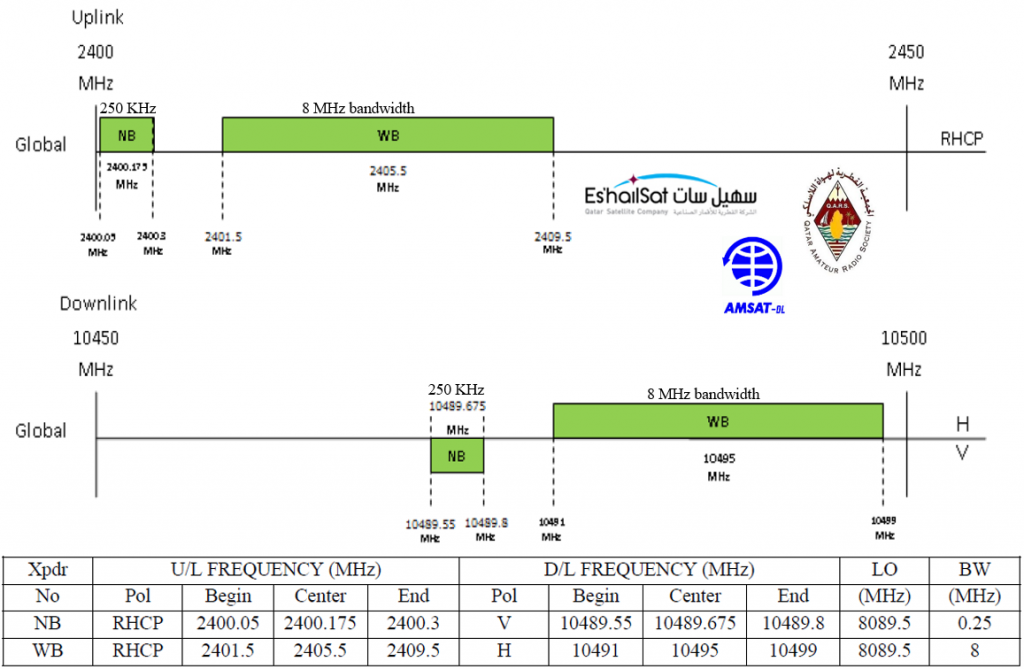
While reading about the new 802.11ax (WiFi-6) protocol which re-utilizes the 2.4GHz band for WiFi technologies, I came across an article about using the same band for amateur radio communication via satellite.
It is an “Es’hail-2 / QO-100” satellite (Qatar Oscar 100), launched in November 2018, carrying (among other things) a radio amateur transponder. It is the first radio amateur satellite placed in a geostationary orbit (25.9° East) to allow narrow/wide band communication between radio amateurs from Brazil to Thailand.

In the first part of this text, I will briefly explain communication modes via this satellite, the frequency and the work plan, as well as the steps for modifying equipment necessary for RX / TX.
Communication frequencies
Es’hail-2 has two “Phase 4” amateur radio transponders operating at 2400 MHz and 10450 MHz bands. For standard analogue operations (CW, SSB) a 250 kHz bandwidth transponder is used, and for experimental digital modulation schemes and DVB amateur television (DVB-S2) an 8 MHz bandwidth transponder is used.
The frequencies used to communicate via this satellite are as follows:
- Narrow-band transponder (NB)
• 2400.050 – 2400.300 MHz Uplink
• 10489.550 – 10489.800 MHz Downlink - Wide-band transponder (WB)
• 2401.500 – 2409.500 MHz Uplink
• 10491.000 – 10499.000 MHz Downlink

Although there is no formal band plan, the following details can serve as an initial communication guide…

Basic rules
The same rules that apply for terrestrial radio amateur communications also apply for Es’hail-2 satellite. Among the standard rules for polite communication, the following should also be noted:
- Not stronger than the Beacon, keep your signal below Beacon level.
In cases where such a signal is detected, it will be marked by the “LEILA” siren. When a signal is flagged, the operator must immediately reduce its uplink power (ERP). - No FM mode or any other modulation using a bandwidth greater than 2700 Hz on the NB transponder.
- No digital FM modes such as C4FM, DSTAR…
- No transmission below the lower CW beacon.
The Amateur Satellites Service operate exclusively on a secondary basis in the band 2400-2450 MHz. You are responsibly for you own transmissions! - No transmission above the upper PSK beacon.
- Please keep the “guardband” around the CW & PSK beacon free of transmissions. If you transmit on 10489,795 MHz in USB, your spectrum will be up to .798 MHz and interfere with the PSK beacon.
- The NB transponder is a bent-pipe transponder and non-inverting.
The signal coming to the satellite is amplified, switched from uplink to downlink frequency and sent back to Earth. - Uplink polarisation is RHCP
(right-hand circular polarization) - Downlink polarisation for the NB transponder is V.
(vertical linear polarization) - Full-Duplex operation is mandatory.
Operator must be able to monitor his own downlink while transmitting! - The Upper Beacon is modulated in 400 bit/s BPSK.
- The beacons are generated by the groundstation and will carry additional operational or maintenance information.
- Remote operation over Internet (Gateway traffic) is undesirable and only permitted during disaster communication.
Communication equipment
… for Es’hail-2 / QO-100 satellite:
- X-Band 10 GHz Downlink:
• 89 cm dishes in rainy areas at EOC like Brazil or Thailand
• 60 cm around coverage peak
• 75 cm dishes at peak -2dB
• NB: linear vertical polarisation
• WB: linear horizontal polarisation - S-Band 2.4 GHz NB-Uplink:
• narrow band modes like SSB, CW
• 5W nominal Uplink power (22.5 dBi antenna gain, 75cm dish)
• RHCP polarisation - S-Band 2.4 GHz WB-Uplink (DATV):
• wide band modes, DVB-S2
• peak EIRP of 53 dBW (2.4m dish and 100W) required
• RHCP polarisation
Amateur RX/TX radio equipment
In order to get involved in this kind of amateur radio communication, I started to acquire necessary equipment.
Receiver (RX)
For the receiving part (just for the beginning), I use WebSDR. It is a SDR receiver connected to the Internet owned by a British amateur TV club based in Cornwall (UK).
This receiver can be accessed via https://eshail.batc.org.uk/nb/

Through this site, and before embarking on their own design of the receiver, the radio amateur can get acquainted with the operating frequencies and see how it “sounds” live.
You can make your own receiver using the following equipment:
- Appropriate satellite dish diameter
• 60 and 90cm testing is yet to be done - Downconverter
• satellite X-band LNB
• lowers the 10.489MHz signal
• https://ukamsat.files.wordpress.com/2019/03/on215-qo100-downconverter.pdf - SDR receiver
• reception from about 25MHz to 1700MHz
• eg. RTL-SDR v3
• https://www.rtl-sdr.com/buy-rtl-sdr-dvb-t-dongles/ - Computer to display and demodulate signals through appropriate software
• SDR# (SDRSharp)
• https://airspy.com/download/
Transmitter (TX)
As an SSB transmitter for analog (narrowband) mode, I will try to use an older “FDK Multi-750e” radio device, designed for 2m operation. The unit provides FM, LSB/USB and CW mode, with a transmit power of 1/10W. The plan is to use this device as SSB 144MHz transmitter, to which I will connect transverter to 2400MHz, followed by an RF amplifier and eventually an antenna for this band.
The FDK Multi-750e radio comes from the 80’s. It is an amateur radio device at 144MHz (2m), which had an affordable price, and could buy an appropriate 432MHz (70cm) transmitter controlled via the front panel.

Many of these devices still exist, but have stopped working because of very common errors:
- trimmer pots of the device are subject to intermittent operation
• especially those on the transmitter amplifier module - cold solder points
• they are all over the place!
The device I bought wasn’t in working condition, and I need to repair it first. Stay tuned…
73 de YU2MP
